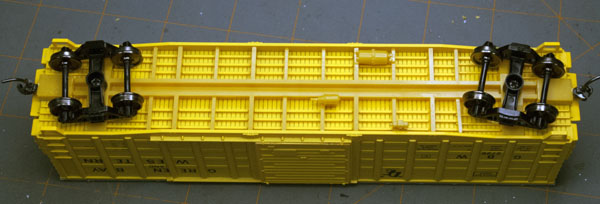(Near) Brainless Modeling
I have been solving problems with Locomotive programming using JMRI and my Power Cab to reset two of Jack's E6As to work together.

Also helping with AP EE documentation and detailed scratch building on my Woodboro buildings was taxing my brain.


So Sunday night I decided I wanted to do something that was easy and somewhat without thought. (Near Brainless)
In honor of the closing of Carstens publications I thought I would add this 2008 Accurail kit to the (Near Brainless collection)

I turned to the plastic tubs under the layout to look at car kits. What I found was a set of Walther’s kits from the early 1990s. These kits were acquired in many ways by gift, hobby shop purchase and whole layout purchase. I collected them but had not built these. Looking at the GBW 50’ Box car I decided to give it a go.

These kits have beautiful lettering jobs on the cars but the basic paint presents a problem. It seems that they did a great job in creating the molds for these kits but did not allow for the thickness of the paint that would be applied to the raw plastic coming out of the molds. And part that had a pin to go in a hole both the pin and the hole needed to have the paint removed. The coat of paint was such that I decided to use ACC rather than plastic cement as I was gluing paint not plastic in most locations. Details were masked in some locations by the thick paint job.

With all this said the cars did provide (near) brainless kit building and turned out nice looking cars that will be ready for a good weathering job. I say this because some of the parts were painted and others like the frame were molded in colored plastic that does not match the paint. Under body painting will be needed to cover this error, not a problem as the prototype is weathered grimy black and rusted anyway.

The other thing that needed work was the trucks. I found that I could watch the 10 o’clock news while honing out the journal boxes so that new metal wheels would spin freely in the trucks. The amount of work varied widely from wheel set to wheel set showing the molding flash and error in the trucks.
A plus was the choice doors for the waffle boxcars. I was able to use different doors on each side of one car and on the yellow GBW I placed a brown replacement door like the car had been serviced on a RIP track.

Different doors were also placed on the CNW waffle box car.


The biggest challenge was on, of all things, a flat car. The car comes with the choice of normal flat, early TOFC, modern TOFC or bulkhead flat car. With my lumbering lines I decided to build the bulkhead car. The car was no problem but the bulkhead parts were so coated in paint that fitting them and cementing them together was a real problem.

This took time and thought (not part of the deal) but I was successful in using ACC and cementing my fingers to the bulkhead parts. Sanding paint and refitting the non interlocking parts to make up the bulkhead supports did workout but will need repainting. If these parts had been cast in a color of plastic that could go without painting, then plastic cement would have made the assembly simple and effective.
All in all this has been fun and has provided me with a set of cars to airbrush weather without concern of failure to produce a fine model. I have 2 more to go, WC a covered hopper in cement service and a 50’ covered hopper with pressure rather than Air Slide service.

Tonight this turned into the car below.

The trucks are done so its build the kits. And then off to the airbrush booth.

And here is the next with the weight drying flat.
Updated 09/03/14
Join us in the “Greatest Hobby” as a member of the TLMRC.

